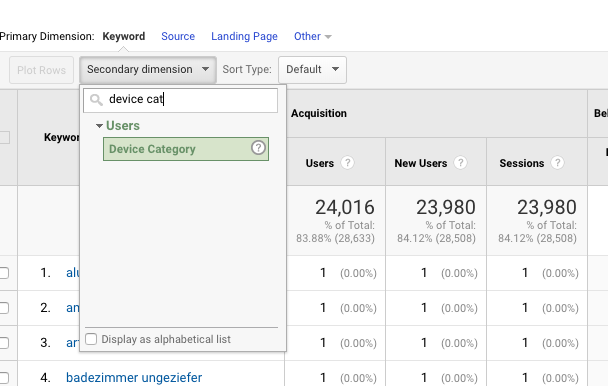Enhance Your Information Analysis Utilizing Secondary Dimension in Google Analytics
Discovering the abilities of second measurements in Google Analytics opens up a realm of opportunities for refining information analysis. By layering added measurements onto main data collections, an even more complex story arises, losing light on individual interactions and efficiency signs.
Recognizing Secondary Measurements
In the world of information evaluation, an important element to grasp is the principle of second dimensions and their significance in extracting deeper insights from Google Analytics records. Second measurements in Google Analytics refer to additional specifications that can be added to the key measurement, enabling an extra detailed evaluation of information. By incorporating second dimensions, experts can segment and filter information to discover patterns, fads, and relationships that could not appear when considering the information as a whole. These secondary dimensions can offer context and a much more extensive understanding of individual actions, web traffic sources, and other essential metrics tracked by Google Analytics.

Benefits of Using Secondary Dimensions
When examining data in Google Analytics, the utilization of secondary dimensions provides vital insights into user behavior and performance metrics. By including a second dimension to your key data, you can delve deeper into the attributes of your internet site visitors and their interactions. One of the vital benefits of making use of additional measurements is the capability to section and contrast information more efficiently. This segmentation permits you to recognize just how various variables, such as demographics or traffic resources, impact user behavior and conversions (Secondary Dimension in Google Analytics).
In addition, secondary measurements assist in recognizing patterns and relationships that may not be promptly obvious when considering the data alone. This much deeper level of evaluation can discover valuable info that can lead advertising and marketing approaches, website optimization, and total organization decisions. Furthermore, additional dimensions enhance the context of your primary information, offering an extra comprehensive sight of user interaction and performance metrics. Overall, making use of additional dimensions in Google Analytics can significantly improve the deepness and top quality of your data evaluation, leading to even more enlightened decision-making and enhanced outcomes.
Exactly How to Include Additional Measurements
By integrating second dimensions in Google Analytics, users can obtain much deeper insights into their information evaluation process, permitting for even more comprehensive analysis of customer habits and performance metrics. Adding second measurements is a straightforward process that can considerably improve the deepness of evaluation. As soon as in the report, locate the "Additional dimension" tab above the data table.
Studying Information With Secondary Dimensions
Utilizing secondary dimensions in information analysis supplies a much more extensive understanding of user habits and efficiency metrics. By including an additional dimension to your primary information established in Google Analytics, you can dig much deeper right into the attributes of your website site visitors and their interactions. Combining the key measurement of 'source/medium' with the additional measurement of 'landing page' can reveal which details pages are attracting website traffic from different resources, assisting you enhance these pages for much better engagement.

Essentially, analyzing data with second dimensions empowers you to gain valuable insights into individual behavior, identify patterns, and make notified decisions to improve the performance of your digital residential or commercial properties.
Finest Practices for Additional Measurements
In data evaluation, incorporating second dimensions efficiently can considerably boost the depth of understandings acquired from metrics and user actions patterns. When using additional measurements in Google Analytics or any various other analytical tool, it is essential to comply with ideal techniques to ensure the accuracy and relevance of the information evaluation.
One secret ideal practice is to carefully select second dimensions that match the key measurement being assessed. Picking secondary measurements that provide added context or further division can supply a more comprehensive understanding of the data. It is additionally important to avoid overcomplicating the analysis by consisting of as well lots of second measurements, which might lead to complication or dilution of understandings.
In addition, it is suggested to explore different combinations of additional and key dimensions to reveal brand-new connections and patterns. Frequently fine-tuning the option and evaluating of secondary dimensions based on the details objectives of the evaluation can bring about even more actionable understandings. By adhering to these best techniques, browse around here data experts can leverage second dimensions successfully to improve the overall information analysis process and decision-making abilities.

Conclusion
To conclude, including second measurements in Google Analytics is essential for a thorough information evaluation strategy. By leveraging secondary dimensions together with main ones, look what i found marketing experts and experts can uncover important understandings and correlations that can notify decision-making and maximize digital marketing methods. Understanding how to successfully make use of additional dimensions and adhering to best practices will enable experts to draw out significant information and improve their overall performance metrics.
Additional measurements in Google Analytics refer to additional specifications that can be added to the primary dimension, permitting for a more detailed evaluation of data. By incorporating secondary dimensions, analysts can segment and filter information to uncover patterns, fads, and connections that might not be evident when looking at the data as a whole. Incorporating the main dimension of 'source/medium' with the second dimension of 'landing page' can disclose which certain pages are attracting web traffic from various sources, aiding you enhance these web pages for far better engagement.
One key best technique is to carefully pick second dimensions that match the main measurement being analyzed. By complying with these best methods, data analysts can leverage secondary dimensions properly to improve the total data analysis he said process and decision-making capabilities.